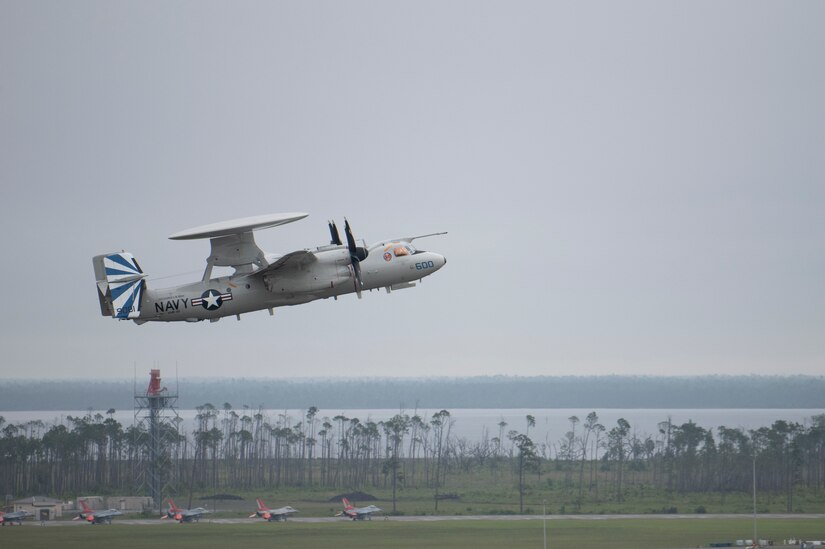
A joint team of Air Force and Navy command and control units exercised advanced joint command and control during two air dominance events at Tyndall Air Force Base recently.
Throughout the month of May, Tyndall hosted two simultaneous large force exercises preparing the Joint Force for operations in a highly contested environment—Checkered Flag 21-2, Air Combat Command’s largest air dominance exercise, and Combat Archer, the Air Force’s Weapon System Evaluation Program for air-to-air live-fire evaluations.
During these events, more than 100 U.S. Air Force and Navy aircraft took off from Tyndall, Eglin AFB, Cecil Field, Jacksonville International Airport, Florida, and Naval Air Station New Orleans, Louisiana, for the skies over the Gulf of Mexico and northern Florida. Both CF 21-2 and Combat Archer included relied on the expertise of three C2 units: Tyndall’s 81st Air Control Squadron, which provided ground-based C2 using sensors and communication equipment along the Florida coast; the 960th Airborne Air Control Squadron from Tinker AFB, Oklahoma, providing E-3G AWACS aircraft; and the U.S. Navy’s VAW-121 from NAS Norfolk, Virginia, flying four E-2D Advanced Hawkeye aircraft. The integration of these units enabled them to explore C2 operating concepts that contribute to the Advanced Battle Management System.
“Exercises such as Checkered Flag and Combat Archer, as well as the size and aspects of the Eglin Test and Training Range (EGTTR), are uniquely suited to practicing the advanced C2 concepts we might encounter in a highly-contested environment,” said U.S. Air Force Lt. Col. Mitch “Digger” Mayes, 81 ACS director of operations. “The EGTTR’s battlespace is over 56,000 square miles, and threat replication systems such as the QF-16 from the 82d Aerial Target Squadron and electronic warfare capabilities fielded by the 53d Test Support Squadron allow C2 agencies to exercise tactics, techniques, and procedures rarely integrated in other large force events. This means we have the advanced threat-replication to challenge C2 sensors, the distances to exercise C2 concepts at extended stand-off distances, and the maneuvering airspace to practice survivability tactics without being encroached upon by commercial air traffic.”
Another unique aspect of CF 21-2 was the ability for C2 units to enhance their effectiveness where multiple C2 units’ area of responsibilities meet.
“Though we tend to focus much of our training on ‘blue forces’ versus ‘red forces,’ a major challenge for C2 in any complex battlespace is managing the communication and coordination between multiple C2 units at the seams of their AORs,” Mayes said.
Combat Archer also provided unique C2 integration during air-to-air live-fire missile operations. The 83d FWS led visiting fighter squadrons in shooting 54 AIM-120 and AIM-9 missiles at unmanned drone aircraft replicating potential adversary threats. The squadron’s program managers and analysts enhance the experience of combat-ready Air Force and Navy pilots by providing detailed debriefs of the missile employment, as well as collecting vital data on the continued performance of these weapons.
Normally, C2 for Combat Archer is provided solely by the 81 ACS; however, during this exercise the E-2D integrated with the 81 ACS to increase situational awareness and enhance lethality of fourth and fifth-generation fighters. This marked the first time the E-2D supported Air Force and Navy fighters during live-fire weapons evaluations while also providing C2 against simulated adversary aircraft, replicating the most advanced air threats present around the globe.
“The events during these two weeks are the seeds of actually executing a redundant and resilient C2 architecture agnostic to type or service providing a resilient, redundant, and survivable model on which to build,” said Col Nick Reed, 53d Weapons Evaluation Group commander.
Because the EGTTR is one of the few places where combat-coded active duty forces can employ combat-stock live air-to-air weapons, the 81st ACS was also able to collect and analyze how fighters share information with C2 while live-weapons are being employed. This information will contribute how current and emerging C2 systems can more effectively and efficiently deliver swift and dynamic C2 in a high-end fight.
"control" - Google News
July 30, 2021 at 03:11AM
https://ift.tt/3l7XSY7
Air Force, Navy units provide joint command and control for the high-end fight - Tyndall Air Force Base
"control" - Google News
https://ift.tt/3bY2j0m
https://ift.tt/2KQD83I
Bagikan Berita Ini














0 Response to "Air Force, Navy units provide joint command and control for the high-end fight - Tyndall Air Force Base"
Post a Comment